| Article: |
Introduction
Every item of rolling stock that runs on the mainline British railway network is assigned a unique number for the purposes of identification and management of operation, maintenance etc. There is not however one single series of numbers. Different types of trains (for example, locomotives, coaches and multiple units ) are numbered in different series, while some types (primarily wagons) can be numbered in one of several different series. The aim of this article is to give an overview of the different number series in use at present (2019). Other articles go into more detail about individual types of train and numbering systems used in the past.
This article - and indeed most of this website - is concerned with 'mainline' trains. That is, trains which are permitted to operate on the British national network of routes, currently managed by Network Rail. Trains which only operate on other lines (for example urban underground or metro lines, industrial, private or military networks and 'heritage' railways) do not have to be numbered in a nationally standardised way.
Locomotives
All locomotives working on the British mainline are assigned a five-digit number which is usually shown on both sides (and sometimes also on the end) of the loco. These are the TOPS numbers and are formed of a two-digit class number followed by a three-digit serial number. For example, 66001 was the first loco in class 66, though it should be mentioned that serial numbers do not always start at 001. The two sections (class number and serial) are sometimes separated by a space. Classes 01 to 70 are assigned to diesel locomotives, and (generally speaking) the higher the class number, the greater the power of the loco. Hence class 01 are the smallest diesel shunting locos, while 66, 68 and 70 are high-power, mainline locos. Classes 73 to 92 are electric locos or 'hybrid' electric and diesel locos. Locos dedicated to departmental duties are grouped together as class 97.
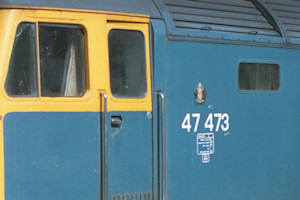 47473 47473 shows a space between the class (47) and the serial (473). 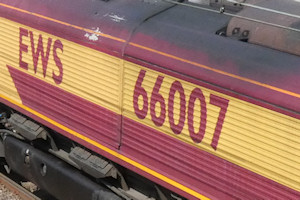 More recent locos, such as this class 66, do not have a gap between the class and the serial. Significant variations within classes are covered by sub-classes. For example, 37601 is the first loco in sub-class 37/6. The sub-classes are usually (but not always) sequential, the serial numbers of a sub-class usually (but not always) start at xxx01, and the first digit of the serial number often (but not always) indicates the sub-class. The class 66 locos illustrate several of these points.
The first class 66s to be built were 250 for EWS, numbered 66001 to 66250. While these were the only examples, there was no need to use a sub-class. When Freightliner ordered some locos, they were numbered from 66501 upwards, presumably to allow for future expansion of the EWS fleet. These were classified as 66/5, while the EWS batch became class 66/0. Therefore, 66250 (for example) is a 66/0 rather than a 66/2. The next sub-class was a variant for Freightliner, numbered 66601 upwards and classified 66/6. This later caused problems when the 66/5 class reached 99 examples. The next batch of 66/5s had to be numbered 66953 upwards. Class 66/8 was introduced in 2009 when Colas Rail bought some second-hand locos. As numbers 66801 to 66840 were already in use as coach side numbers (qv) these were numbered 66841 upwards.
Coaching stock
Coaching stock covers both un-powered, passenger (or parcel) carrying vehicles designed to be hauled (or pushed) by a locomotive, and also the coaches that make up multiple units (which are usually formed of a mixture of powered and un-powered coaches). All current coaches have a number of between three and six digits, which is shown on each side. Most multiple units also have a number for the complete set and to distinguish these the coach numbers are sometimes referred to as 'side' numbers, while the unit numbers are similarly either 'set' or 'end' numbers.
'Side' numbers are usually carried at the right-hand end of each side, low on the body. It is sometimes moved to the left-hand end (notably on multiple units coaches where the cab is at the right-hand end) or higher up at the centre (to reduce the risk of being obscured by grafitti).
Prefix and/or suffix letters used to be added to indicate the coaches allocation and origins but most numbers today are plain.
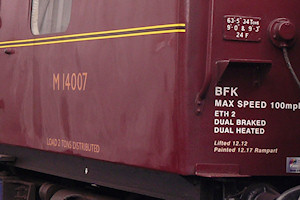 Side numbers were traditionally placed near the right-hand end of each side, half-way between the solebar and the window-line. 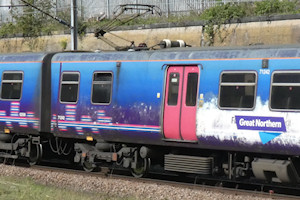 Just about visible in this photo is the car number carried at the left-hand end of a driving car (which has a cab out of shot on the right), and also the repeated number at high level near the center. The vast majority of current coaches have numbers in the BR coaching series, first used shortly after British Railways was formed in 1948. The exceptions are a few which still carry numbers in the private owner series, which was otherwise used primarily for wagons. Under BR, coach numbers were grouped into blocks in the range 1 to 99999 (ie no more than 5 digits). For example, sleeper coaches were all numbered in the range 2001 to 2899. The system has remained in use ever since, although numerous changes (due to the introduction of new types, and renumberings due to modifications or to remove duplications) have made the organisation a little bit confused.
By the time the railway was being privatised in the 1990s, many of the number blocks had been used up. New builds were assigned numbers that either fell outside the earlier organisation system (such as the Class 378 EMUs which were given side numbers in the 38xxx series), or which re-used numbers. There was a general rule that if a group of numbers had been out of use for seven years or more, then they could be used again. This has been most common with multiple units as these have formed the majority of new builds in the past few decades. In 2014 a decision was made to expand the coaching stock series to include six-digit numbers, and this has been used for most new-build multiple units since. This has enabled more units to have side numbers that are related to their set number, something which was often attempted with the five-digit numbers but not always possible. For example, unit 375601 and series are formed of 67801+74251+74201+67851, 67802+74252+74202+67852 and so on, only the last digit of each coach number being the same as the last digit of the set number. With six-digit numbers the logic is clearer. Unit 707001 is formed of 421001+422001+423001+424001+425001, whereby the third digit of each coach number indicates the coach position in the set, while the final three digits are the same as the set serial number.
Wagons
Wagons are the most complicated group of rolling stock in terms of numbering. All wagons have a number comprised of either four, five, six or twelve numerical digits, which can also be prefixed by between one and four letters. The wagon fleet has reduced in size dramatically over the past few decades and the majority of the current fleet is numbered in one of the following series:
- Six-digit numbers (sometimes with a two- or three-letter prefix) - This is the 'railway owned' series, rendered rather meaningless by privatisation. It in fact covers two series, the B-prefixed series (of which the main survivors are bogie flat wagons in the DB979xxx and DB996xxx ranges) and the air-braked series. These two series originally had overlaps but these have been removed by withdrawals.
- Four- and five-digit numbers, with a two- three- of four-letter prefix - This is the 'private owner' series, where the prefix letters indicate the owner of the wagon.
- Twelve-digit numbers - These are RIV 'international' numbers, also known as EVNs (European Vehicle Numbers). As the name implies, this series of numbers is standardised across Europe (and slightly beyond). It was initially used only on wagons that operated to and from the continent but, since 2008, has been used for all new-build wagons.
Confusing the issue further is the use of numbers in the CEPS series (covered in the section on departmental vehicles) for items of rolling stock that are actually wagons. CEPS numbers have five numerical digits and two (or more) letter prefixes. This has lead to some situations that could cause confusion due to duplicated numbers. For example, GMC92502 and DR92502 are both bogie flat wagons Following the adoption of EVNs for new builds, there seemed to be some confusion as to whether new numbers also had to be allocated to wagons that were converted or modified. Two groups of wagons ended up being assigned EVNs in addition to their existing numbers. First were the rebogied HKA hoppers, which changed from being numbered in the private-owner series as NP196xx to corresponding numbers in the railway-owned series (3006xx) and the EVN series (82.70.6723.6xx-x).
Over 200 bogie steel wagons were rebuilt with open box bodies as type MXA from 2015 onwards and these were allocated new EVNs in the series 82.70.4703.xxx in addition to their existing railway-owned 9xxxxx numbers. The new numbers were assigned in the order the conversions were completed, so bear no relation to the original numbers. As with the HKAs, both numbers are displayed on the wagons.
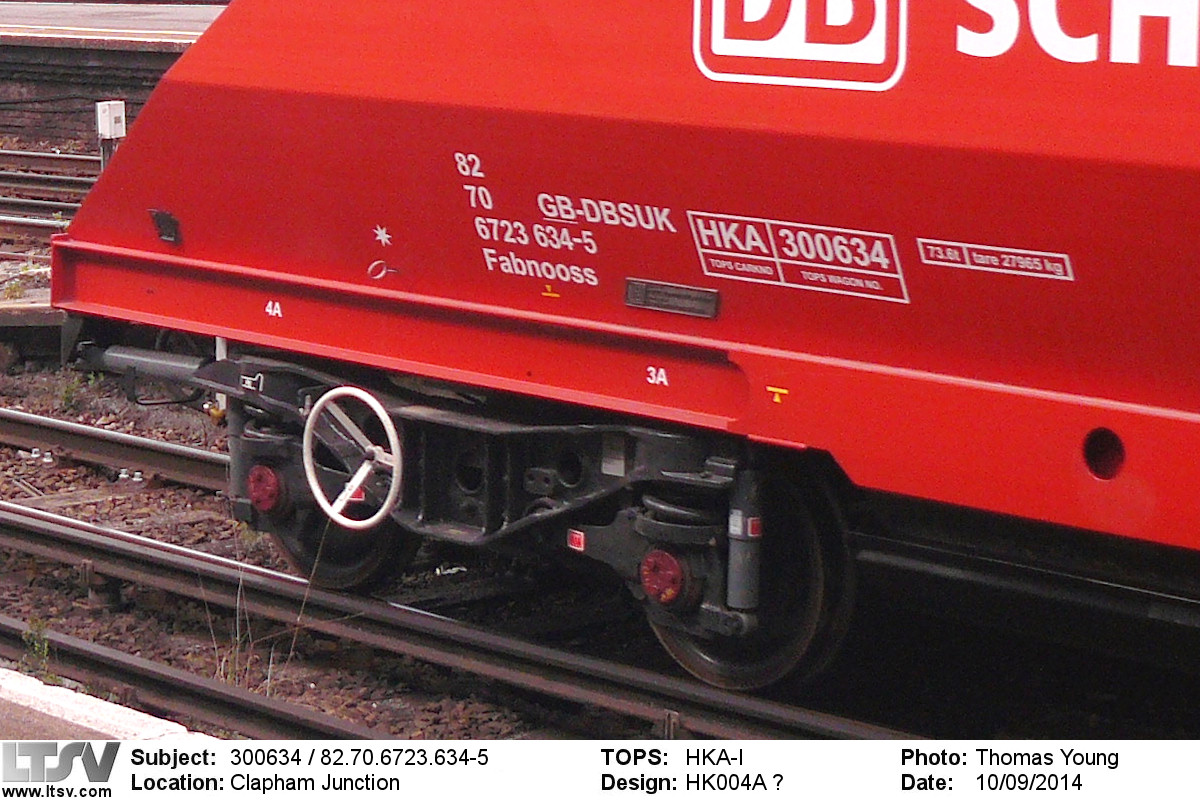 This wagon clearly carries two different (though related) numbers. The hopper-shortening projects over the past few years show how the numbering policies have varied. The HRA conversions for DB got new EVNs in place of their existing numbers, while most of the HYA and IIA rebuilds for GBRf retained their previous numbers (apart from one batch which got EVNs in a new class block). The ex-Freightliner HHAs are also intended to keep their original 370xxx numbers.
Departmental Stock
To be covered shortly
|

 Register
Register